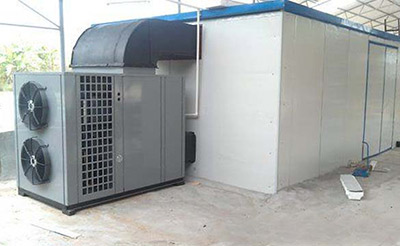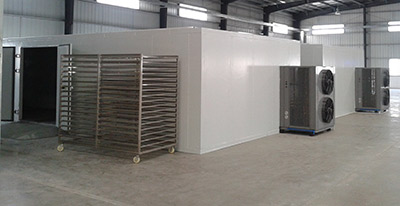 Scanair industrial dryers strongly committed to quality, our range of products are fabricated in the way of walk in Drying Chamber / Drying room / Drying Equipment according to customers requirements, Elevated Temperature / Cold room with humidity control, heated room with steamer control etc. Chamber with Hot / Cold / Dry / Wet with full digital control features.
Scanair industrial dryers strongly committed to quality, our range of products are fabricated in the way of walk in Drying Chamber / Drying room / Drying Equipment according to customers requirements, Elevated Temperature / Cold room with humidity control, heated room with steamer control etc. Chamber with Hot / Cold / Dry / Wet with full digital control features.
One of the most efficient and controllable ways of drying moisture materials is by using a heat pump drying. For years heat pumps have been known as an efficient method of energy recovery. Heat pump for drying is difference, of the hot heat produced by condenser and cold heat by the evaporator will be use currently during the operation. The heat from the condenser will produced hot and will use to heat the material and the cold heat from the evaporator will be use in dehumidifying process. Their ability to convert the latent heat of vapour condensation into the sensible heat of an air stream passing through the condenser makes them attractive in drying applications especially when combined with the ability to produced well-controlled drying conditions in the drying room.
Principle of Drying Room
 Crop drying is the process of removing water from food by circulating hot dry air through it. Hot air is required to vaporize the moisture contained by the solid, and air flow is necessary to remove the vapor. For effective drying, air should be hot and dry and moving and moisture must migrate from within the product to the product’s surface, as this is where the moisture exchange with the air occurs. There are two stages in a typical drying process the first stage is the removal of surface moisture the second stage is the removal of ‘internal moisture’ from within the solid material. The drying process is therefore divided into a “constant rate’’ period and a “falling rate’’ period.
Crop drying is the process of removing water from food by circulating hot dry air through it. Hot air is required to vaporize the moisture contained by the solid, and air flow is necessary to remove the vapor. For effective drying, air should be hot and dry and moving and moisture must migrate from within the product to the product’s surface, as this is where the moisture exchange with the air occurs. There are two stages in a typical drying process the first stage is the removal of surface moisture the second stage is the removal of ‘internal moisture’ from within the solid material. The drying process is therefore divided into a “constant rate’’ period and a “falling rate’’ period.
During the constant rate drying period, the surface of the material is still wet and the rate of drying is governed by evaporation of free moisture from the product’s surface or near surface areas. The rate of drying is dependent on the vapour pressure difference between the surface and the air. Drying air temperature, air velocity and shape and size of the drying materials can significantly affect the drying rate. As drying progresses, the product’s surface is no longer wet, but dry portions of the solid jut out into the drying air film. The drying rate falls and moisture must move from the product’s interior to the surface before it is in this period that the crop usually achieves its final desired moisture content that is safe for storage. Drying in this period is strongly dependent upon the drying air temperature.


Comments are closed.